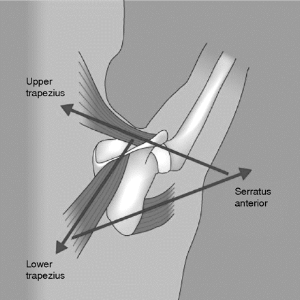Scapular Rotator Muscle Imbalance in Swimmers with Subacromial Impingement Symptoms
Authors: M. J. Smith, V. Sparkes, S. Enright
References: British Journal of Sports Medicine 2007;41:118-124. 2007.
Abstract
Introduction: Relative muscle imbalance of the scapular rotators has been implicated in shoulder pain of a subacromial impingement (SI) nature. Previous studies have reported altered scapular rotator muscle strength1 and timing in overhand athletes with SI symptoms. The aim of this study was to investigate relative muscle activity of the scapular rotators in swimmers with SI symptoms and in normal control subjects during a dynamic test movement.
Methods: Twenty swimmers who demonstrated unilateral SI symptoms on clinical testing were recruited, along with 40 non-injured subjects. Surface electromyography (EMG) was used to measure bilateral muscle activity of the scapular rotators (upper fibres of trapezius (UFT), lower fibres of trapezius (LFT) and serratus anterior (SA)) during repeated humeral elevation in the scapular plane. Relative muscle activity was calculated by dividing the mean EMG of each scapular rotator by the activity of the other individual scapular rotators. A one-way ANOVA with post hoc Tukey was used to look for differences in ratios of muscle activity between groups and sides.
Results: Injured subjects demonstrated a significantly (p = 0.001) higher ratio of UFT:LFT activity on both the symptomatic (mean 3.3, SD 1.8) and asymptomatic sides (mean 3.3, SD 1.9) compared to the uninjured subjects (mean 1.8, SD 1.4). There was no statistically significant difference between sides or between injured and non-injured subjects in UFT:SA or LFT:SA activity.
Conclusions: The results of the study provide evidence of relative scapular rotator muscle imbalance between UFT and LFT in symptomatic athletes and that the activity was bilaterally altered in the presence of unilateral symptoms. These findings indicate that such imbalance should be considered in the assessment and rehabilitation of symptomatic SI sporting populations.



